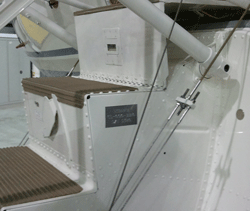Contributed by Scott Shefke, Airframe Tech Rep.

An ID plate identifying the aircraft must be displayed in a pominent position near the main entrance.
SAFA ramp inspections are occurring more often to N-registered aircraft operating in EASA-controlled countries. The purpose of these inspections is to ensure aircraft are meeting minimum standards in several areas, such as emergency exit, altimeters, flight recorders, GPWS, ELT and electronic navigation data management. The list goes on and on. The complete list from for the SAFA Program can be found here: http://www.icao.int/FSIX/_library/coscapsea/ Reference_ANNEXES_for_
ICAO_Ramp_Inspections_Guidance_2009_07_02.pdf.
Identification Plate Requirement
On page seven (7) of the above document is a reference to a required Identification Plate that must be displayed in a prominent position aboard the aircraft. ID Plates are not required by the FAA in the United States, but if you plan to fly in EASA-controlled countries, be aware that you will need to have a plate installed or risk getting hit with a fine during a SAFA Inspection.
A8. Documents required to be carried on board - Identification Plate
“An aircraft shall carry an identification plate inscribed with at least its nationality or common mark and registration mark. The plate shall be made of fireproof metal or other fireproof material of suitable physical properties and shall be secured to the aircraft in a prominent position near the main entrance or, in the case of an unmanned free balloon, affixed conspicuously to the exterior of the payload.”
The reference gives direction as to the material the plate must be made from, but nothing is stated about the dimensions.
If you want to make your own plate, one OEM recommends cutting it to .98” x 3.94” from a .063” stainless steel sheet. Engrave the plate with .60” high lettering at an engraving depth of .04”. One operator said he went to his local trophy engraving shop and had them make a placard. He installed it in a prominent place using a two-part epoxy.
Scott Shefke is an Airframe Tech Rep. located at Duncan Aviation's Lincoln, Nebr., facility. He specializes in educating operators about and troubleshooting the Challenger and Global airframes. Scott currently services on Bombardier's Challenger 600 Series Advisory Board and Bombardier Industry Steering Committee. His aviation career began in 1991.


